External Trade
Hong Kong's merchandise exports staged a strong rebound over the course of 2002, amidst continued robust demand in the Mainland and a resurgence in intra-regional trade, as well as revived import absorption in the conventional overseas markets. Improvement in Hong Kong's external price competitiveness brought about by a weaker US dollar rendered an additional boost.
For 2002 as a whole, Hong Kong's total exports of goods (comprising re-exports and domestic exports) had a notable growth at 8.6 per cent in real terms, representing a significant turnaround from the 3.3 per cent fall in 2001. Moreover, there was a distinct upturn over the course of the year. Although total exports declined by 2.5 per cent in real terms in the first quarter of 2002 over a year earlier, they had already reverted to positive growth at 5.9 per cent in the second quarter, and even accelerated to 11.4 per cent and 18.3 per cent respectively in the third and fourth quarters. On a seasonally adjusted quarter-to-quarter comparison, total exports of goods rose throughout the four quarters, by 4.5 per cent, 5.8 per cent, 4.0 per cent and 4.0 per cent respectively in real terms (Chart 9).
| Chart 9 | Hong Kong's visible
trade (year-on-year rate of change in real terms) |
|
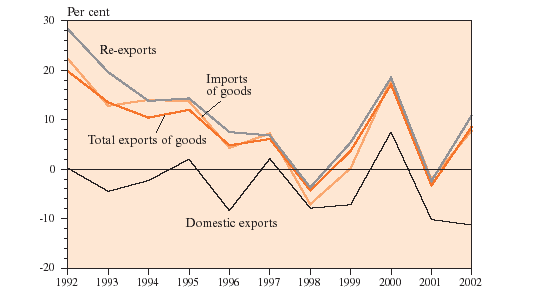 |
||
| Total exports of goods,including in particular re-exports, bounced up distinctly in 2002,reversing the decline in 2001. Imports of goods likewise rebounded visibly. | ||
Within total exports of goods, re-exports remained the key driver of export performance, attaining double-digit growth at 10.9 per cent in real terms in 2002. This represented a sharp turnaround from the 2.4 per cent decrease in 2001. On the other hand, owing to the ongoing structural shift towards re-exports and offshore trade, domestic exports shrank further, by 11.3 per cent in real terms in 2002, slightly larger than the 10.2 per cent dip in 2001.
Imports of goods likewise rebounded, rising by 7.8 per cent in real terms in 2002, also distinctly improved from the 2.0 per cent decline in 2001. Mirroring the profile of pick-up in re-exports over the course of the year, imports of goods, after falling by 4.1 per cent in real terms in the first quarter of 2002 over a year earlier, resumed positive growth at 5.7 per cent in the second quarter, and then recorded double-digit growth at 10.8 per cent and 18.1 per cent respectively in the third and fourth quarters. Imports retained for local use likewise revived during the year, though at a less robust pace than re-exports. On a seasonally adjusted quarter-to-quarter comparison, imports of goods rose by 4.5 per cent, 5.8 per cent, 4.8 per cent and 2.9 per cent respectively in real terms through the four quarters of 2002. Analysed by major source, the Mainland continued to be the largest import supplier for Hong Kong, accounting for 44 per cent of the total value in 2002. Other major sources included Japan (with a share of 11 per cent), Taiwan (7 per cent), the United States (6 per cent), the Republic of Korea (5 per cent) and Singapore (5 per cent).
As the value of total exports of goods rose faster than the value of imports of goods, the visible trade deficit (reckoned on a balance of payments basis) shrank to $39.4 billion or 2.5 per cent of the value of imports of goods in 2002, from $65.0 billion or 4.2 per cent in 2001.
On invisible trade, exports of services exhibited an even stronger performance than exports of goods, with double-digit growth at 11.7 per cent in real terms in 2002, as against the 6.9 per cent growth in 2001. Moreover, there was an acceleration in the growth rate of exports of services over the course of the year, from 6.0 per cent in real terms in the first quarter to 7.7 per cent in the second quarter, and further to 13.9 per cent and 18.1 per cent respectively in the third and fourth quarters. By contrast, imports of services remained relatively weak, up by only 0.2 per cent in real terms in 2002, after a modest rise of 2.0 per cent in 2001. Yet the growth rate likewise picked up over the course of the year, from decreases of 0.7 per cent and 3.8 per cent respectively in real terms in the first two quarters to increases of 2.0 per cent and 3.4 per cent in the third and fourth quarters. With exports of services growing much faster than imports of services, the invisible trade surplus (reckoned on a balance of payments basis) expanded markedly, to $163.7 billion or 84.7 per cent of the value of imports of services in 2002, from $133.4 billion or 69.3 per cent in 2001. Together with a much reduced visible trade deficit, this led to a sharp rise in the combined surplus (reckoned on a balance of payments basis) to $124.3 billion or 6.9 per cent of the total value of imports of goods and services in 2002, from $68.5 billion or 3.9 per cent in 2001 (Chart 10).
| Chart 10 | Hong Kong's invisible
trade (year-on-year rate of change in real terms) |
|
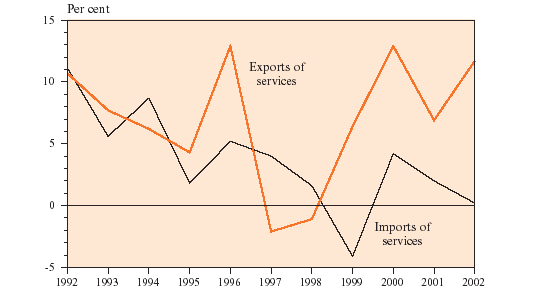 |
||
| Exports of services rose at a more rapid pace in 2002 than in 2001, underpinned by a broad-based surge in inbound tourism, offshore trade and transportation services. Imports of services only recorded modest increases in both years. | ||
Domestic Demand
Local consumer spending remained subdued in most of 2002, as consumers' willingness to spend was held back by high unemployment, moderated income, and weak asset prices. Even with the support of a significant upsurge in inbound tourism in the year, the volume of retail sales still contracted by 2.6 per cent in 2002, after a 1.2 per cent increase in 2001. A relative improvement in retail business nevertheless emerged in the latter part of the year, upon steadier employment conditions and an even stronger surge in incoming visitors. Private consumption expenditure (PCE) likewise dropped in 2002, though to a lesser extent than the decline in retail sales, as the sustained growth in spending on consumer services cushioned the setback in spending on goods. On a year-on-year comparison, PCE fell in all four quarters of 2002, by 0.1 per cent, 2.2 per cent, 1.2 per cent and 1.8 per cent respectively in real terms. For 2002 as a whole, PCE decreased by 1.3 per cent in real terms, reversing the increase of 1.6 per cent in 2001. This was the first annual decline recorded since 1998.
Government consumption expenditure (GCE) reckoned on a national accounts basis rose moderately throughout the four quarters of 2002, by 2.3 per cent, 3.0 per cent, 3.5 per cent and 0.8 per cent respectively in real terms over a year earlier. For 2002 as a whole, GCE went up by 2.4 per cent in real terms, yet considerably slower than the 6.1 per cent increase in 2001. On a seasonally adjusted quarter-to-quarter comparison, GCE had a meagre growth at 0.4 per cent in real terms in the first quarter of 2002. It edged lower by 0.2 per cent in the second quarter, rebounded by 2.3 per cent in the third quarter, but fell back by 1.2 per cent in the fourth quarter.
Overall investment spending, as represented by gross domestic fixed capital formation (GDFCF), remained weak in most of 2002. Continuing the setback towards the end of 2001, GDFCF plummeted by 11.8 per cent in real terms in the first quarter of 2002 over a year earlier. This was followed by lesser declines of 0.2 per cent, 4.3 per cent and 0.7 per cent respectively in the second, third and fourth quarters. For 2002 as a whole, GDFCF fell by 4.3 per cent in real terms, after a 2.7 per cent rise in 2001.
The relapse in overall investment spending in 2002 was mainly due to a sharp fall-off in expenditure on machinery, equipment and computer software, amidst an uncertain business outlook and an overhang of excess capacity. Such expenditure plummeted by 9.1 per cent in real terms for 2002 as a whole, which contrasted with a 6.2 per cent increase in 2001. There were marked declines by 19.8 per cent, 6.7 per cent and 12.2 per cent respectively in real terms in the first three quarters of 2002 over a year earlier, though followed by a rebound to a 3.2 per cent increase in the fourth quarter, helped in part by a low base a year earlier.
On the other hand, expenditure on building and construction, having declined for four consecutive years, turned up to a modest increase of 1.2 per cent in real terms in 2002. This was attributable to increases in such expenditure by 7.6 per cent and 8.2 per cent respectively in the second and the third quarters, which more than offset the decreases in the first and the fourth quarters by 3.2 per cent and 6.2 per cent. Private sector building activity picked up around the middle of the year, yet tapered off in the fourth quarter. Public sector building and construction activity stayed weak for most of 2002, and was on a decline for three years in a row. The MTR Tseung Kwan O Extension was completed in August 2002, while work on the KCR West Rail had been winding down. Output under the Public Housing Programme also continued to shrink (Chart 11).
| Chart 11 | Main components of
domestic demand (year-on-year rate of change in real terms) |
|
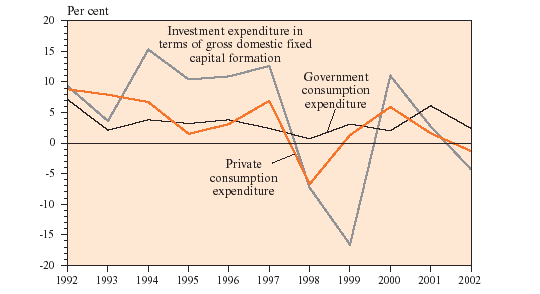 |
||
| Local consumer spending slackened in 2002, as consumer sentiment was dampened by high unemployment, moderated income and soft asset prices. Concurrently, overall investment spending weakened, as expenditure on machinery, equipment and computer software plummeted amidst an uncertain business outlook and an overhang of excess capacity. As for government consumption expenditure, the growth rate in the year was modest. | ||
Net Output or Value Added by Economic Activity
In the first three quarters of 2002, the net output or value added of the services sector as a whole was 2.0 per cent higher in real terms than a year earlier, modestly exceeding the 1.6 per cent increase in 2001. Analysed by constituent sectors and on a year-on-year comparison in real terms, net output in transport, storage and communications rose by 3.2 per cent in the first three quarters of 2002, underpinned by a further growth in international telephone and mobile phone traffic volumes, as well as by an expansion in cargo handling activity upon a rebound in external trade. In addition, net output in the wholesale, retail and import/export trades, restaurants and hotels increased by 1.8 per cent, along with an upturn in trade-related services and inbound tourism. Net output in community, social and personal services also went up by 0.8 per cent, mostly attributable to increases in education and social welfare services. Net output in financing, insurance, real estate and business services edged up by 0.4 per cent, as increased real estate and insurance businesses were virtually offset by reduced financing and business services.
On the other hand, net output in the local manufacturing sector continued to decline, by 9.4 per cent in real terms in the first three quarters of 2002 over a year earlier, further to a 8.6 per cent fall in 2001. The weak performance of domestic exports and an ongoing relocation of production processes outside Hong Kong were the major dampening factors. As to the construction sector, net output went up by 1.2 per cent in real terms in the first three quarters of 2002 over a year earlier, reversing a 4.3 per cent fall in 2001. This was mainly attributable to more intensive work on some of the major private sector development projects during the year (Chart 12).
| Chart 12 | Net output or value
added by major economic sector (year-on-year rate of change in real terms*) |
|
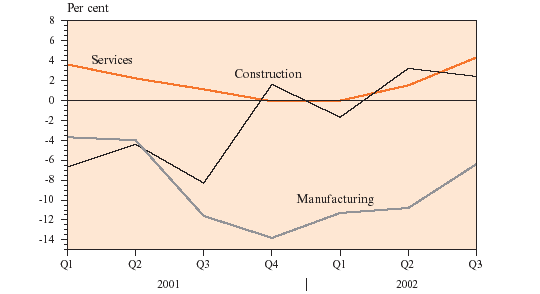 |
||
| Net output of both the services and construction sectors
showed modest
increases in 2002. Net output of the manufacturing sector, however,
continued to decline. * Growth rates before the first quarter of 2001 are not available. |
||
The Labour Market
The labour market, though still slack in 2002, showed some improvement in the latter part of the year, when total employment picked up amidst an upturn in economic activity. For 2002 as a whole, the unemployment rate averaged at 7.3 per cent, markedly higher than that of 5.1 per cent in 2001. A surge in the seasonally adjusted unemployment rate was observed in the early part of the year, from 6.2 per cent in the fourth quarter of 2001 to 7.0 per cent and 7.7 per cent respectively in the first two quarters of 2002, and further to a peak of 7.8 per cent in May–July, consequential to more extensive downsizing and lay-offs in the corporate sector. This was followed by a steady decline in the latter part of the year, to 7.4 per cent in the third quarter and then to 7.2 per cent in the fourth quarter. On the median duration of unemployment, there was a distinct lengthening over the year, from 82 days in the fourth quarter of 2001 to 90 days in the fourth quarter of 2002. The proportion of persons unemployed for six months or more likewise went up visibly, from 24 per cent to 30 per cent.
The underemployment rate also moved higher, averaging at 3.0 per cent in 2002, as against 2.5 per cent in 2001. It rose from 3.0 per cent in the fourth quarter of 2001 to 3.2 per cent in the first quarter of 2002, then declined to 2.9 per cent in both the second and third quarters, but edged up again to 3.1 per cent in the fourth quarter (Chart 13).
| Chart 13 | Unemployment and underemployment rates | |
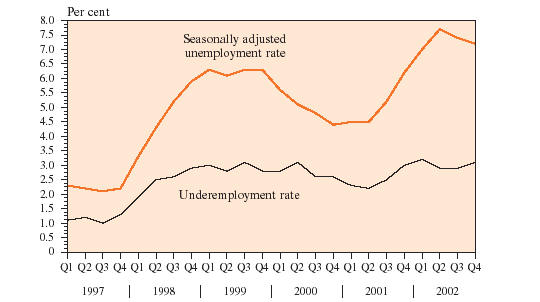 |
||
| The labour market remained generally slack in 2002. Despite a gradual decline in the latter part of the year, the unemployment rate for 2002 as a whole was distinctly higher than that in 2001. The underemployment rate also edged up during the year. | ||
For persons in employment, work intensity was high. The proportion of employed persons working for 50 hours or more per week rose visibly, from 35 per cent in the fourth quarter of 2001 to 40 per cent in the fourth quarter of 2002, as did the proportion of employed persons working for 60 hours or more per week, from 21 per cent to 24 per cent. This reflected greater work effort being exerted by the employed workforce in general, as the corporate sector underwent further staff consolidation in 2002. Taking all the employed persons together, the median hours of work stayed at 48 hours per week for most of the year.
Total employment as enumerated from households bounced up towards the end of 2002, to a year-on-year increase of 0.8 per cent in the fourth quarter, having worsened from a 1.0 per cent decrease in the first quarter. Total labour force had a faster growth in 2002, with the year-on-year increase picking up to 2.0 per cent in the fourth quarter, from 1.7 per cent in the first quarter. The swing in the growth rate differential between total labour force and total employment pointed to a relative narrowing in the overall manpower resource balance, leading to a lower unemployment rate in the latter part of 2002 (Chart 14).
| Chart 14 | Total labour force
and total employment (year-on-year rate of change) |
|
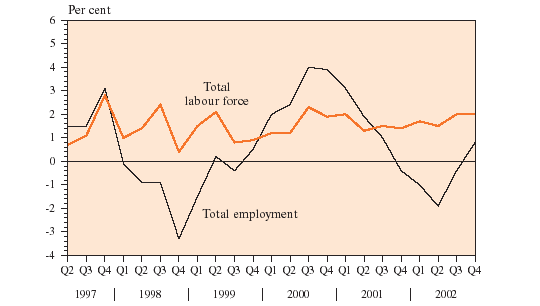 |
||
| Total labour force continued to show steady growth in 2002. Total employment had a lesser decline in the third quarter of 2002, and then went up in the fourth quarter. This led to a fall in the unemployment rate in the latter part of the year. | ||
Employment as enumerated from business establishments continued to decrease, along with further consolidation and rationalisation in the corporate sector. For all the private sector establishments surveyed taken together, total employment shrank by 1.5 per cent in September 2002 over a year earlier, following decreases of 1.1 per cent in March and 2.7 per cent in June. For the first nine months of 2002 as a whole, total employment dwindled by an average of 1.8 per cent, after increasing by only 0.2 per cent in 2001. On a seasonally adjusted quarter-to-quarter comparison, total employment was virtually static in September 2002, having decreased by 0.7 per cent in March and 0.6 per cent in June.
Taking all the service sectors surveyed together, employment fell by 0.4 per cent in September 2002 over a year earlier, yet narrowed from the 2.1 per cent decline in June. Employment growth varied considerably amongst the constituent sectors. On a year-on-year comparison, employment in storage and communications contracted visibly, by 7.3 per cent in September 2002, attributable to further consolidation in the telecommunications sector. Employment in restaurants and hotels and in the retail trade dropped by 4.8 per cent and 1.7 per cent respectively, amidst subdued local consumer demand, and notwithstanding buoyancy in inbound tourism. Employment in financing, insurance, real estate and business services and in water transport, air transport and services allied to transport declined by 2.9 per cent and 0.6 per cent respectively. On the other hand, employment in the wholesale and import/export trades went up, albeit only marginally, by 0.2 per cent, in tandem with an upswing in external trade. Employment in community, social and personal services had a larger increase, by 5.7 per cent, underpinned by sustained strong demand for welfare, education, medical and health, sanitary and recreational services.
As to the local manufacturing sector, its workforce underwent further downsizing, amidst continued weak performance of domestic exports and ongoing relocation of production processes to the Mainland. In September 2002, employment in this sector was reduced further, by 9.2 per cent from a year earlier, after an 8.5 per cent dip in June.
Employment of manual workers at building and construction sites also shrank visibly, by 8.0 per cent in September 2002 over a year earlier, much enlarged from the 1.3 per cent fall in June. This was mainly due to the significant reduction in employment at public sector sites, upon progressive scaling back of the Public Housing Programme and completion of the MTR Tseung Kwan O Extension. Concurrently, employment at private sector sites likewise dropped, as reduced employment in quite a number of private building sites more than offset the gain seen at the construction site for Container Terminal No. 9. Taking into account off-site workers and related professional and support staff, employment for the entire building and construction sector was 2.7 per cent less in the third quarter of 2002 than a year earlier, albeit smaller than the 4.4 per cent decline in the second quarter (Chart 15).
| Chart 15 | Employment by broad economic sector | |
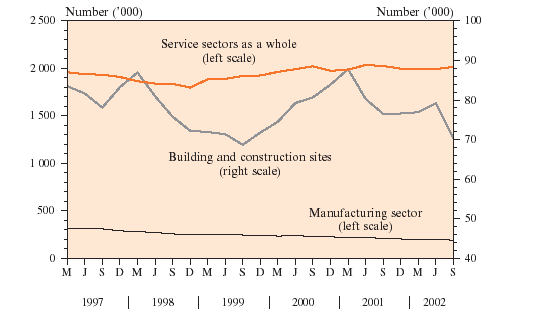 |
||
| Employment as enumerated from business establishments had a broad-based decline across many of the major economic sectors in 2002. Yet for all the service sectors taken together, employment showed a smaller decrease in September 2002 than in June. On the other hand, employment in the local manufacturing sector and at building and construction sites fell to a larger extent over the period. | ||
Overall labour earnings fell by 1.5 per cent in money terms in the third quarter of 2002 over a year earlier, larger than the declines of 0.6 per cent and 1.0 per cent respectively in the first and second quarters. Yet discounting an enlarged fall in consumer prices, overall labour earnings still gained by 2.1 per cent in real terms in the third quarter of 2002 over a year earlier, which was similar to the increases of 2.1 per cent in the first quarter and 2.2 per cent in the second quarter. For the first three quarters of 2002 as a whole, overall labour earnings declined on average by 1.0 per cent in money terms over a year earlier, but were still up by 2.1 per cent in real terms. In 2001, overall labour earnings were higher both in money terms and in real terms, by 1.8 per cent and 3.5 per cent respectively. On a seasonally adjusted quarter-to-quarter comparison, overall labour earnings edged down by 0.3 per cent in money terms in the third quarter of 2002, similar to the decreases of 0.2 per cent in the first quarter and 0.3 per cent in the second quarter. In real terms, they moved up by 0.5 per cent in the third quarter of 2002, having risen by 0.7 per cent in the first quarter and 0.6 per cent in the second quarter.
Overall labour wages in the private sector fell by 1.5 per cent in money terms in September 2002 over a year earlier, again exceeding the declines of 0.8 per cent in March and 0.9 per cent in June. Discounting an enlarged drop in consumer prices, overall labour wages nevertheless moved higher by 2.8 per cent in real terms in September 2002 over a year earlier. This came after increases of 1.2 per cent in March and 3.1 per cent in June. For the first nine months of 2002 as a whole, labour wages fell on average by 1.1 per cent in money terms over a year earlier, yet still went up by 2.4 per cent in real terms. In 2001, labour wages rose both in money terms and in real terms, by 0.8 per cent and 3.4 per cent respectively (Chart 16).
| Chart 16 | Earnings and wages (year-on-year rate of change in money terms) |
|
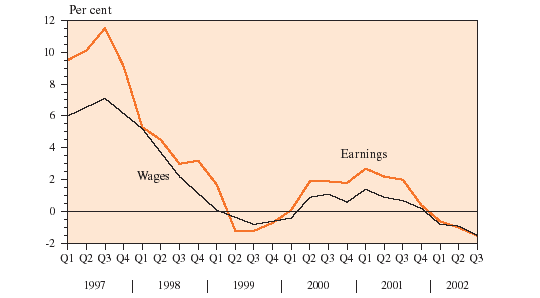 |
||
| Amidst the slack labour market conditions, overall labour earnings and wages showed renewed decreases in money terms in the first three quarters of 2002 over a year earlier, although they were still up in real terms. | ||
Analysed by economic sector, labour earnings drifted lower across all the constituent sectors. Taking all the service sectors surveyed together, earnings decreased by 1.8 per cent in money terms in the third quarter of 2002 over a year earlier, larger than the 1.2 per cent decline in the second quarter. In real terms, earnings nevertheless rose in both quarters, by 1.8 per cent and 2.1 per cent respectively. Amongst the various service sectors, earnings in restaurants and hotels had a more distinct decrease, by 3.0 per cent in money terms in the third quarter of 2002 over a year earlier, though still higher by 0.5 per cent in real terms. Earnings in transport, storage and communications, in community, social and personal services, and in the wholesale, retail and import/export trades were down by around 2.1–2.5 per cent in money terms, albeit up by around 1.0–1.5 per cent in real terms. Earnings in financing, insurance, real estate and business services fell by 1.4 per cent in money terms, but rose by 2.2 per cent in real terms. As to the local manufacturing sector, earnings declined by 1.1 per cent in money terms in the third quarter of 2002 over a year earlier, after a 0.6 per cent fall in the second quarter. Yet in real terms, there were still increases of 2.6 per cent and 2.7 per cent respectively in the two quarters.
As for labour wages in the service sectors, those in personal services, in restaurants and hotels, and in the wholesale, retail and import/export trades went down by 3.0 per cent, 2.7 per cent and 2.0 per cent respectively in money terms in September 2002 over a year earlier. These nevertheless corresponded to increases of 1.3 per cent, 1.6 per cent and 2.4 per cent in real terms. Wages in transport services and in financing, insurance, real estate and business services were unchanged in money terms in September 2002 over a year earlier, but were up by 4.4 per cent in real terms. In the local manufacturing sector, wages declined by 1.5 per cent in money terms in September 2002 over a year earlier, yet rose by 2.8 per cent in real terms.
The Property Market
The property market as a whole underwent further consolidation in 2002. Acquisition and lease demand generally fell short of absorbing the abundant supply, both existing and in the pipeline, and this led to a continued softening in property prices and rentals. Yet the markets for different types of property faced somewhat different circumstances and difficulties.
The sales market for residential property remained generally slack in 2002. While flat prices went down visibly further, there was a modest revival in transaction volume from 2001. The market began the year with trading activity being sustained at a relatively high level. Market sentiment was lifted by the encouraging results of the two land auctions held in April and June, as well as the Government's announcement that it would resume the sale of subsidised flats, in a cautious and orderly manner, after expiry of the 10-month moratorium at end-June. But acquisition interest dwindled during most of the ensuing months, amidst renewed concern about job security and income instability, falling share prices and, in particular, the ample supply of new flats. The brief revival in trading volume seen in September was mainly stimulated by a fresh round of sales promotion by developers, through offering even larger price discounts and other more generous concessions to prospective purchasers. As a result, the primary market diverted the demand further and the secondary market was weakened even more. Towards the year-end, market activity again showed some pick-up, mainly spurred by the Government's promulgation of nine policy measures to stabilise the housing market.
On a quarter-to-quarter comparison, flat prices declined on average by 2 per cent, 5 per cent and 5 per cent respectively in the second, third and fourth quarters of 2002, having shown nil change in the first quarter. For the year as a whole, flat prices on average fell by 12 per cent. Against the peak level in the third quarter of 1997, flat prices in the fourth quarter of 2002 plummeted by an average of 62 per cent. Following the marked decline in flat prices and successive cuts in mortgage rates, and notwithstanding reduced household income, there was a substantial improvement in home purchase affordability over the past several years.
The rental market for private residential flats remained subdued in 2002. Apart from a lesser lease demand upon the impact of reduced salaries and housing allowances, there appeared to have been an increased supply of flats for lease from those hitherto for sale. Flat rentals came under greater downward pressure in those areas with a considerable number of newly completed flats. On a quarter-to-quarter comparison, private housing rentals on average declined by 4 per cent, 3 per cent, 3 per cent and 4 per cent respectively in the four quarters of 2002. For the year as a whole, there was on average a drop of 13 per cent. Against the peak level in the third quarter of 1997, private housing rentals were significantly down in the fourth quarter of 2002, by an average of 43 per cent. Mainly consequential to the distinct fall in flat rentals, lease affordability likewise improved over the past several years (Chart 17).
| Chart 17 | Prices and rentals
of residential property (1999=100) |
|
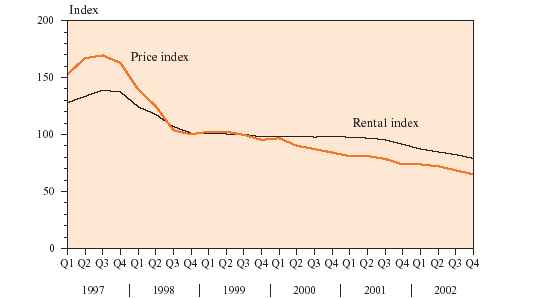 |
||
| Prices and rentals of residential flats both continued to drop during 2002, with sentiment mostly staying subdued and amidst an abundant supply relative to demand in the market. | ||
On commercial property, the rental market for office space weakened further in 2002, as demand continued to be dampened by the ongoing process of downsizing and rationalisation in the business sector. Grade A office space was additionally hit by an excess supply, particularly in the central business district. Also relevant was the move by some companies to relocate their offices to secondary districts as a cost-cutting measure. In order to uphold the occupancy rate, landlords generally offered larger rental cuts, longer rent-free period and other concessions to their tenants. On a quarter-to-quarter comparison, office rentals on average fell by 6 per cent, 5 per cent, 2 per cent and 2 per cent respectively in the four quarters of 2002. For the year as a whole, office rentals on average dipped by 13 per cent. The sales market for office space was stagnant in 2002. Reduced rental yield against the heavy capital investment up-front had led potential purchasers to stay on the sideline. On a quarter-to-quarter comparison, prices of office space were static in the first and third quarters of 2002 but were lower on average by 3 per cent in the second quarter and 5 per cent in the fourth quarter. For the year as a whole, there was on average a fall of 8 per cent. Against their respective peak levels in 1997, prices and rentals of office space both plunged, by an average of 71 per cent and 48 per cent in the fourth quarter of 2002 (Chart 18).
| Chart 18 | Prices and rentals
of office space (1999=100) |
|
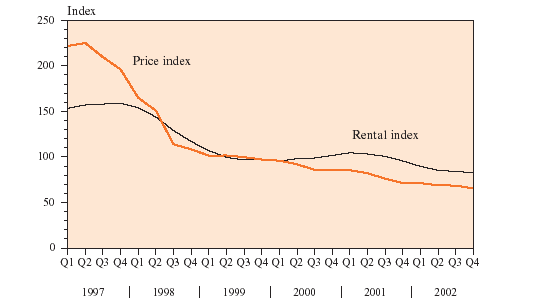 |
||
| Prices and rentals of office space remained on a distinct downtrend during 2002, amidst further downsizing and rationalisation in the business sector. | ||
The rental market for shopping space was slack in 2002, as demand remained languid amidst a continued setback in the retail trade. Space in well-managed shopping arcades and in the popular shopping districts was nevertheless better sought after. On a quarter-to-quarter comparison, shop rentals on average went down by 3 per cent and 1 per cent respectively in the first two quarters of 2002, yet held steady in the third and fourth quarters. For the year as a whole, there was on average a 5 per cent drop. The sales market for shopping space remained quiet in 2002, as investors continued to adopt a cautious attitude in the face of subdued conditions in the retail trade and an uncertain near-term outlook. On a quarter-to-quarter comparison, prices of shopping space, having on average held steady in the first quarter of 2002 and edged up by 3 per cent in the second quarter, fell by 1 per cent and 4 per cent respectively in the third and fourth quarters. For the year as a whole, there was on average a decline of 1 per cent. Yet against their respective peak levels in the third quarter of 1997, prices and rentals of shopping space both tumbled, by an average of 57 per cent and 26 per cent in the fourth quarter of 2002.
The rental market for industrial property was inactive in 2002. Demand for conventional factory space was restrained by a further contraction in local manufacturing activity. Demand for modern industrial premises for use as data centres and back-up service centres was also on the wane, amidst further consolidation in the information technology sector. On a quarter-to-quarter comparison, rentals of industrial space drifted lower in the first three quarters of 2002, on average by 2 per cent, 3 per cent and 2 per cent respectively, before edging up by 1 per cent in the fourth quarter. For the year as a whole, rentals of industrial space on average fell by 7 per cent. The sales market for industrial property was at a standstill in 2002, with a lack of buying interest. On a quarter-to-quarter comparison, prices of industrial space on average fell by 3 per cent each in the first, third and fourth quarters of 2002, more than offsetting the 2 per cent rise in the second quarter. For the year as a whole, there was on average a decrease of 7 per cent. Against their respective peak levels in 1994, prices and rentals of industrial space both slumped, by an average of 68 per cent and 46 per cent in the fourth quarter of 2002.
| Chart 19 | Sale and purchase agreements by broad type of property | |
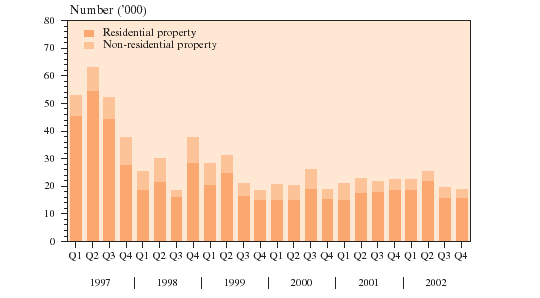 |
||
| Transactions in residential property showed a modest increase in 2002, but this was offset by a visible decline in transactions in non-residential property. | ||
On supply of new property, completions of private residential property rose sharply by 30 per cent in 2002, well beyond the 2 per cent increase in 2001. Completions of office space recorded an even larger rise, by 117 per cent in 2002, representing a sharp turnaround from the 20 per cent decrease in 2001. On the other hand, completions of shopping space showed only a moderate increase, by 5 per cent in 2002, after surging by 105 per cent in 2001. As to industrial property, completions were reduced further by 35 per cent in 2002, following a fall of 28 per cent in 2001.
Property transactions, as measured by agreements for sale and purchase of property registered with the Land Registry, shrank by 3 per cent in number in 2002. The decrease was concentrated in the second half of the year, outweighing the increase in the first half. In 2001, there was a rise of 3 per cent. In total value, property transactions were also down, by 4 per cent in 2002, which was nevertheless smaller than the 13 per cent drop in 2001. Analysed by main type of property, transactions in residential property rose modestly, by 5 per cent in number and 2 per cent in total value in 2002. The increase occurred mainly in the first half of the year. By contrast, transactions in non-residential property contracted considerably, by 30 per cent in number and 26 per cent in total value in 2002. There was a much larger decline in the first half of the year than in the second half (Chart 19).
Price Movement
Overall consumer prices continued to decline in 2002. By December, overall consumer prices had fallen for 50 consecutive months. Though with some relative narrowing towards the year-end, the decrease for 2002 as a whole widened considerably from that in 2001. This reflected mostly the influence of domestic factors. In particular, there were the special relief measures of rates concession and waiver of water and sewage charges implemented by the Government during the year. Also, domestic costs were lessened by softening in both labour wages and property rentals. Meanwhile, local retailers cut the prices of their goods and services further, in face of slack consumer demand and keen competition in the retail market. On the external front, while import prices stayed soft in overall terms, the decline moderated over the course of the year, upon a weaker US dollar and a rebound in world commodity prices.
For 2002 as a whole, the Composite Consumer Price Index went down by 3.0 per cent, nearly double the 1.6 per cent fall in 2001. There was an enlargement in the year-on-year decrease for most of the year, from 2.6 per cent in the first quarter to 3.2 per cent in the second quarter and further to 3.5 per cent in the third quarter. To a large extent, this was due to the two rounds of rates concession as well as the waiver of water and sewage charges granted as from the early part of 2002. (Discounting the effect of these special relief measures, the decline widened only modestly over the period.) Also relevant were further reductions in the prices of basic foodstuffs and in the charges of such service items as mobile phone and other telecommunications services. The year-on-year decrease then narrowed to 2.9 per cent in the fourth quarter of 2002. Yet this was mostly attributable to a low base of comparison a year earlier, caused by a waiver of public housing rentals in December 2001.
Analysed by sub-index, the CPI(A), CPI(B) and CPI(C) all came down, by 3.2 per cent, 3.1 per cent and 2.8 per cent respectively for 2002 as a whole, larger than the decreases of 1.7 per cent, 1.6 per cent and 1.5 per cent in 2001. For the CPI(A) and CPI(B), the respective year-on-year declines likewise accelerated, from 2.8 per cent and 2.7 per cent in the first quarter of 2002 to 3.6 per cent and 3.1 per cent in the second quarter and further to 4.1 per cent and 3.4 per cent in the third quarter, before moderating to 2.4 per cent and 3.2 per cent in the fourth quarter. As to the CPI(C), the year-on-year decrease, having enlarged from 2.5 per cent in the first quarter of 2002 to 2.9 per cent and 2.8 per cent respectively in the second and third quarters, showed a further widening to 3.0 per cent in the fourth quarter. This was due to the fact that the CPI(C) was unaffected by the waiver of public housing rentals in December 2001.
The GDP deflator, as a broad measure of overall price change in the economy, decreased by 4.1 per cent in the fourth quarter of 2002 over a year earlier. This exceeded the declines of 2.3 per cent, 2.2 per cent and 3.1 per cent in the first three quarters. For 2002 as a whole, the GDP deflator was down by 3.0 per cent, larger than the 1.9 per cent fall in 2001. This was mainly attributable to accelerated drops in the price deflators for private consumption expenditure and for gross domestic fixed capital formation, as well as a renewed decrease in the government consumption expenditure deflator, more than offsetting an improvement in the terms of trade in goods and services. Within the GDP deflator, the domestic demand deflator and the total final demand deflator both showed larger decreases in 2002 than in 2001, by 4.6 per cent and 3.5 per cent respectively as against 2.5 per cent and 2.7 per cent (Chart 20).
| Chart 20 | Main inflation indicators (year-on-year rate of change) |
|
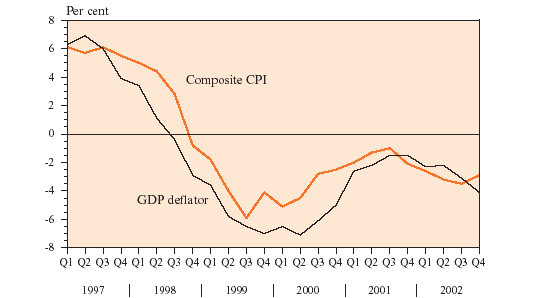 |
||
| Both the Composite CPI and the GDP deflator continued to decline in 2002, extending the downtrend since late 1998. | ||